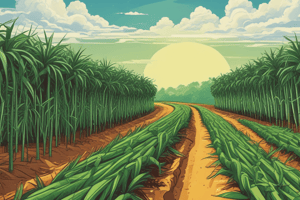Podcast
Questions and Answers
What is the primary cause of damage to sugarcane by the sugarcane shoot borer?
What is the primary cause of damage to sugarcane by the sugarcane shoot borer?
- Larvae (correct)
- Eggs
- Pupa
- Adult moth
How long does it take for the larva of the sugarcane shoot borer to become fully grown?
How long does it take for the larva of the sugarcane shoot borer to become fully grown?
- 35-40 days
- 6-8 days
- 1-6 days
- 25-30 days (correct)
Which symptom is NOT caused by the early shoot borer infestation in sugarcane?
Which symptom is NOT caused by the early shoot borer infestation in sugarcane?
- Yellow Leaves (correct)
- Central Whorl of Leaves
- Damaged Canes
- Dead Hearts
How many days does it take for the adult moth to emerge from the pupa of the sugarcane shoot borer?
How many days does it take for the adult moth to emerge from the pupa of the sugarcane shoot borer?
What term is used to describe the 'dead hearts' formed in young sugarcane plants due to the sugarcane shoot borer?
What term is used to describe the 'dead hearts' formed in young sugarcane plants due to the sugarcane shoot borer?
How long does it take for the entire lifecycle of the sugarcane shoot borer to be completed?
How long does it take for the entire lifecycle of the sugarcane shoot borer to be completed?
What is the impact of sugarcane shoot borers on sugarcane crops?
What is the impact of sugarcane shoot borers on sugarcane crops?
Which management strategy is based on the use of parasitoids to control sugarcane shoot borers?
Which management strategy is based on the use of parasitoids to control sugarcane shoot borers?
How can early planting of sugarcane help in managing shoot borers?
How can early planting of sugarcane help in managing shoot borers?
What role do parasitoids like Trichogramma chilonis play in managing sugarcane shoot borers?
What role do parasitoids like Trichogramma chilonis play in managing sugarcane shoot borers?
What could be a consequence of total crop failure caused by sugarcane shoot borers?
What could be a consequence of total crop failure caused by sugarcane shoot borers?
How does the destruction of crop residues after harvest help in managing sugarcane shoot borers?
How does the destruction of crop residues after harvest help in managing sugarcane shoot borers?
Study Notes
Sugarcane Shoot Borer: Lifecycle, Symptoms, and Impact on Sugar Cane Crops
Sugarcane early shoot borer, known scientifically as Chilo infuscatellus, is a serious pest that affects sugarcane crops in various regions worldwide. The insect's life cycle, symptoms of infestation, and impact on sugarcane are crucial aspects of understanding its behavior and managing its population.
Sugarcane Shoot Borer Lifecycle
The lifecycle of the sugarcane early shoot borer can be divided into four main stages: egg, larva, pupa, and adult. The eggs are laid on the under surface of the leaf sheaths and hatch in 1-6 days. The larvae, which are the primary cause of damage to sugarcane, enter the stem and become fully grown in 25-30 days. After growing to their full size, the larvae pupate inside the stem. The adult moth emerges from the pupa after 6-8 days, and the entire lifecycle is completed in 35-40 days.
Symptoms of Sugarcane Shoot Borer Infestation
The early shoot borer causes several symptoms in sugarcane:
- Dead Hearts: The larvae of the shoot borer cause the formation of 'dead hearts' in young plants. These dead hearts are formed at the shoot stage and can be easily pulled out of the ground.
- Damaged Canes: The borers damage the canes, which can result in a foul odor.
- Central Whorl of Leaves: The central whorl of leaves in the damaged plants dries up.
These symptoms can lead to a significant reduction in sugarcane yield and, in severe cases, can result in total crop failure.
Impact of Sugarcane Shoot Borer on Sugar Cane Crops
The sugarcane early shoot borer has a significant impact on sugarcane crops. The damages caused by the larvae result in a reduction in yield, often leading to economic losses for farmers. The species can survive year-round in mild climates, making it a persistent pest that can damage sugarcane throughout the growing season.
Management Strategies
Several management strategies can be employed to control sugarcane shoot borers:
- Cultural Practices: Early planting can help avoid infestation, as the larvae are less likely to be present at the time of planting. The destruction of crop residues after harvest can help reduce the overwintering of the insects.
- Biological Control: The use of parasitoids, such as Trichogramma chilonis, can effectively control the shoot borer population. Inundative releases of the parasitoid can be made at regular intervals during the growing season.
- Chemical Control: Pesticides like cartap hydrochloride and chlorpyriphos can be used to control the shoot borer. However, it is essential to follow the instructions on the product label to ensure safe and effective pesticide application.
In conclusion, understanding the life cycle, symptoms, and impact of sugarcane shoot borers is crucial for effective pest management. Implementing a combination of cultural, biological, and chemical control strategies can help farmers minimize economic losses and maintain healthy sugarcane crops.
Studying That Suits You
Use AI to generate personalized quizzes and flashcards to suit your learning preferences.
Description
Test your knowledge on the lifecycle, symptoms, and impact of sugarcane shoot borers, a pest that affects sugarcane crops worldwide. Learn about the stages in the insect's lifecycle, symptoms of infestation including dead hearts and damaged canes, and the significant impacts on sugarcane yield. Explore management strategies such as cultural practices, biological control, and chemical control to effectively manage this pest.




